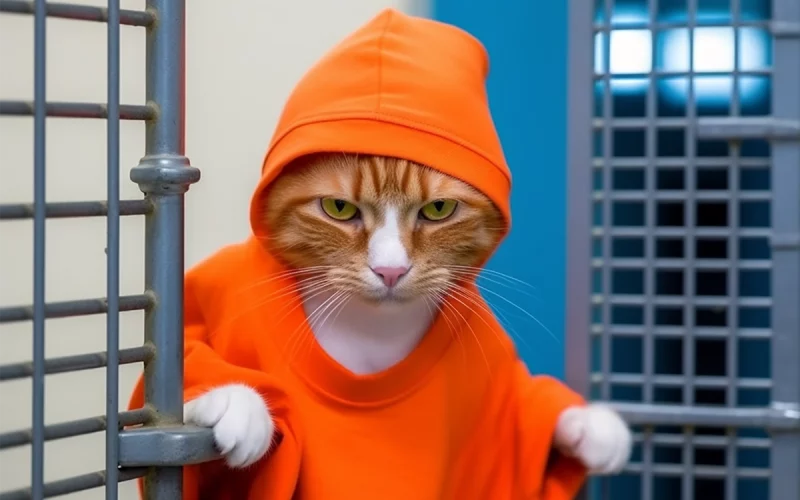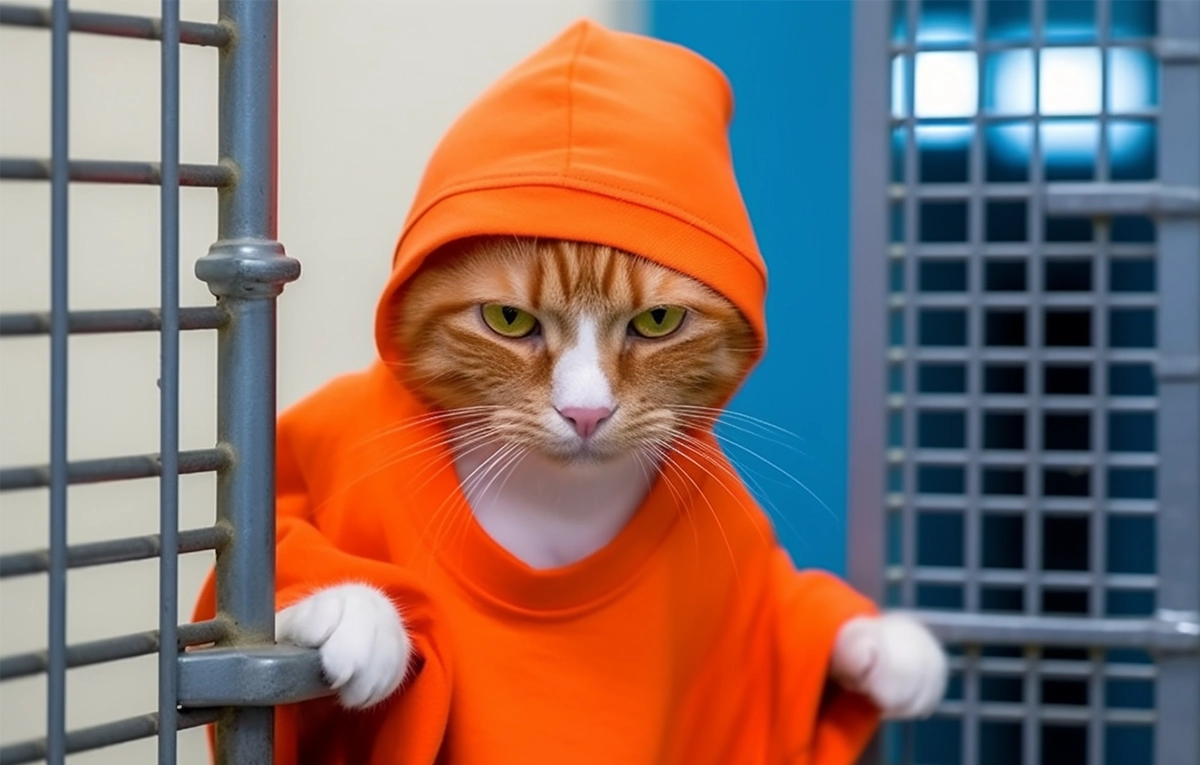Decoding the Quirks: A Deep Dive into Erratic Cat Behavior gives insights into the peculiar actions of cats. This article will delve into the factors behind these behaviors and provide a better understanding of our feline companions.
Exploring both common and unusual actions, we will uncover the reasons behind their sudden outbursts, strange vocalizations, and unpredictable routines. By deciphering these patterns, cat owners can enhance their relationships with their pets, ensuring a happier and more harmonious coexistence.
Whether it’s deciphering the meaning behind a prolonged stare or decoding the purpose of a seemingly random pounce, this in-depth exploration will shed light on the fascinating and often enigmatic behavior of our beloved feline friends.

Credit: kittycone.com
Unusual Behaviors In Cats
When it comes to our feline friends, their behavior can sometimes be a bit perplexing. Cats are known for their independent nature, and often display quirky actions that leave us scratching our heads. In this deep dive into erratic cat behavior, we will explore a couple of the most unusual behaviors in cats: their bizarre eating habits and peculiar sleeping positions.
Bizarre Eating Habits
Cats are notorious for their selective eating habits, which can seem downright bizarre to us humans. From nibbling on plants to obsessively licking plastic bags, cats have unique preferences when it comes to their meals. Some common peculiarities include:
- Eating grass: Cats may eat grass to aid their digestion or to satisfy a nutritional need for certain vitamins and minerals.
- Chewing on cords: The texture of cords can be appealing to cats, leading them to chew on them. This behavior can be dangerous, as it poses a risk of electrical shock or injury.
- Stealing food: Cats are excellent opportunists and may try to sneak bites from our plates when we’re not looking.
If your cat’s eating habits become excessive or worrisome, consulting with a veterinarian is recommended to ensure their health and well-being.
Peculiar Sleeping Positions
Cats are known for their ability to sleep in the most peculiar positions. What may seem uncomfortable to us is often the go-to spot for a cat nap. Some of these sleep positions include:
- The loaf: Cats curl up like a loaf of bread, tucking their paws under their body.
- The upside-down: Cats feel secure enough to sleep on their backs, sometimes with their paws in the air.
- The sprawl: Cats stretch out their legs, with their paws extended in different directions.
It’s important to note that a cat’s sleeping position can also be influenced by their environment and the temperature. Providing a comfortable and cozy space for your cat to rest can help encourage healthier sleep habits.
Communication Quirks
Deciphering the unusual behavior of cats can be a fascinating adventure into their communication idiosyncrasies. Explore the intriguing world of erratic cat behavior and unravel the mysteries behind their quirky ways.
Understanding your cat’s behavior is a key aspect of building a strong bond with your feline companion. While cats may seem mysterious at times, decoding their quirks can shed light on their thoughts and emotions. One important aspect of cat behavior is their communication style. Cats use various cues and signals to express themselves, which can sometimes be puzzling to their human counterparts. In this section, we will explore some of these communication quirks and learn to decipher what our feline friends are trying to tell us.
Tail Movements
When it comes to understanding cat body language, the tale tells it all. A cat’s tail can convey a range of emotions and intentions, so it’s essential to pay attention to its movements. Here are a few tail movements and their typical meanings:
| Tail Movement | Meaning |
|---|---|
| A relaxed, straight tail | The cat is calm and content. |
| A puffed-up tail | The cat is frightened or angry. |
| A tail swishing quickly from side to side | The cat is agitated or irritated. |
| A low, tucked-under tail | The cat is scared or submissive. |
Vocalizations
Cats are known for their wide range of vocalizations, each serving a different purpose. Understanding these vocal cues can give you valuable insights into your cat’s mindset. Here are some common vocalizations and their meanings:
- Meowing: Cats often meow to get attention or communicate their needs.
- Purring: A cat’s purring can indicate contentment, but it can also be a sign of anxiety or pain.
- Hissing: Hissing is a defensive behavior, usually employed when a cat feels threatened or cornered.
- Growling: Growling typically denotes aggression and warns potential intruders to back off.
Paw Gestures
In addition to tail movements and vocalizations, cats also use their paws to communicate. These subtle yet significant gestures convey their intentions and emotions. Here are a few common paw gestures and their meanings:
- Kneading: When a cat kneads its paws against a soft surface, it is a sign of contentment and relaxation.
- Flexing/clenching their paws: This gesture usually indicates fear or discomfort.
- Extended claws: Cats extend their claws when they feel threatened or defensive, showing they are ready for action if needed.
By recognizing and interpreting these communication quirks, you can better understand your cat’s intentions and provide them with the care they need. Remember, every cat is unique, so it’s crucial to observe your feline companion’s behavior patterns and make note of any deviations from their usual signals.
Playtime Antics
One of the most endearing and entertaining aspects of feline behavior is their knack for playtime antics. From Zoomies to spontaneous bursts of energy and unique toy preferences, our furry friends certainly know how to keep us on our toes. In this deep dive into erratic cat behavior, we will explore these playtime quirks and uncover the secrets behind their playful nature.
Zoomies And Spontaneous Burst Of Energy
Cats are known for their wild and unpredictable behavior, and one of the most common manifestations of this is the famous Zoomies. Zoomies occur when a cat suddenly becomes overwhelmed with an uncontrollable desire to sprint around the house, bouncing off walls and furniture like a furry tornado. These episodes of extreme physical activity are a natural outlet for their abundant energy.
During Zoomies, cats may exhibit classic symptoms including dilated pupils, heightened excitement, and an intense need for speed. These bursts of energy often take place during late evening or early morning hours, when our feline friends are most active. While Zoomies can be amusing to witness, it is important to ensure that your home is a safe environment for your cat to indulge in their energetic escapades.
Toy Preferences
Just like humans, cats have individual preferences when it comes to toys. While some felines may go crazy for a feather wand or laser pointer, others may show little interest in these popular options. Understanding your cat’s toy preferences is essential in keeping them engaged and entertained during playtime.
To identify your cat’s favorite toys, observe their reactions and behaviors. Do they pounce on a toy mouse with gusto, or are they more attracted to crinkly balls that they can bat around? Note their preferences and provide a variety of toys that cater to their unique tastes. This will not only keep them entertained but also prevent boredom and potential behavioral issues.
Remember, toy preferences can change over time, so it’s important to periodically assess your cat’s interests and introduce new options accordingly. Regularly rotating their toy selection will prevent them from losing interest and ensure that playtime remains a stimulating and enjoyable experience for both you and your furry companion.

Credit: kittycone.com
Obsessions And Compulsive Behaviors
Curious about your cat’s odd behavior? Delve into the world of feline quirks, decoding their obsessions and compulsive behaviors in this insightful exploration.
Obsessions and compulsive behaviors are common among our feline friends and can sometimes be a source of puzzlement for cat owners. Understanding these quirks can help us provide a supportive and enriching environment for our furry companions. In this article, we’ll explore two intriguing aspects of a cat’s obsessions and compulsive behaviors: Chasing Shadows and Reflections, as well as Excessive Grooming.Chasing Shadows And Reflections
Does your cat go wild when they spot a flickering light or a moving shadow? Rest assured, this behavior is perfectly normal, albeit quirky. Many cats have an instinctual propensity for hunting, and these elusive shadows and reflections trigger their predatory instinct. The swift movements and play of light stimulate the chase response in our feline friends, resulting in pouncing, leaping, and pawing at the intangible prey.Excessive Grooming
Cats are renowned for their fastidious grooming habits, but when does grooming cross the line into compulsive behavior? Excessive grooming, also known as overgrooming, is characterized by relentless and often repetitive cleaning of the fur. While grooming is a natural behavior that helps cats maintain cleanliness, overgrooming can occur due to stress, anxiety, allergies, or even boredom. It’s important to closely monitor your cat’s grooming habits to identify any signs of overgrooming.Signs of Excessive Grooming:
- Bald patches or thinning fur in certain areas
- Red or irritated skin
- Persistent licking or nibbling of the same spot
- Sores or scabs
Socialization Challenges
The socialization challenges faced by cats can be quite perplexing for cat owners. Understanding these challenges is essential in maintaining a harmonious relationship with your feline friend. In this section, we will delve into two significant socialization challenges faced by cats – fear of strangers and territorial tendencies.
Fear Of Strangers
Cats are instinctively cautious creatures, and their fear of strangers is rooted in their wild ancestry. When it comes to new faces, cats can display a range of behaviors, such as hiding, hissing, and even scratching or biting. This fear is often intensified when visitors exhibit sudden movements or loud noises. To help alleviate your cat’s fear, follow these tips:
- Provide a safe space: Create a designated area in your home where your cat can retreat to when feeling overwhelmed.
- Gradual introductions: Allow your cat to become familiar with new people at their own pace, using gentle and positive reinforcement techniques.
- Positive association: Encourage visitors to offer treats or play with interactive toys, associating strangers with positive experiences.
Territorial Tendencies
Cats are known for their strong territorial instincts, which can lead to aggressive behavior towards other cats or even humans encroaching on their perceived territory. These tendencies can manifest through marking territory by urinating or spraying, as well as displaying defensive behaviors like hissing or growling. To manage your cat’s territorial tendencies, consider the following:
- Provide multiple resources: Cats value their personal space, so it’s important to provide enough litter boxes, food, and water bowls for each cat in your home.
- Separate spaces: If you have multiple cats, ensure each has their own space to retreat to, reducing potential conflicts.
- Neutering/spaying: This can help decrease territorial behaviors in cats, particularly in males.
Understanding and addressing these socialization challenges can help create a more peaceful environment for your cat and prevent unwanted behaviors. Remember, patience and positive reinforcement are key in helping your furry friend feel more comfortable and secure in their surroundings.

Credit: meowa.com
Frequently Asked Questions For Decoding The Quirks: A Deep Dive Into Erratic Cat Behavior
How Do You Stop Destructive Behavior In Cats?
To stop destructive behavior in cats, provide plenty of mental and physical stimulation through interactive toys and play sessions. Ensure they have access to scratching posts and provide positive reinforcement for using them. Use deterrents like double-sided tape or citrus scents to discourage scratching furniture.
Consult a veterinarian to rule out any underlying medical issues.
What Is Concerning Cat Behavior?
Cat behavior concerns can include aggression, litter box issues, excessive meowing, and destructive scratching. Understanding why cats exhibit these behaviors is essential for their well-being.
What Does Agitation Look Like In Cats?
Agitation in cats may manifest as restlessness, pacing, growling, hissing, or tail flicking. They may also exhibit dilated pupils, ears flattened, or twitching. Other signs may include excessive grooming or scratching, vocalization, or aggression towards people or other animals.
Why Is My Cat So Agitated All Of A Sudden?
There can be various reasons for your cat’s sudden agitation. It could be due to pain, discomfort, fear, stress, or an underlying medical condition. It’s recommended to observe your cat’s behavior, check for any signs of injury or illness, and consult a veterinarian if the agitation persists or worsens.
Conclusion
Understanding the peculiarities of erratic cat behavior can help cat owners establish a harmonious relationship with their feline companions. By decoding the reasons behind their unusual actions, such as sudden zoomies or nighttime yowling, we can provide them with a stimulating environment and meet their unique needs.
Through patience and observation, we can foster a deeper understanding and connection with our quirky cats, ensuring their happiness and well-being. So, embrace the quirks and enjoy the wonderful journey of cat ownership.

